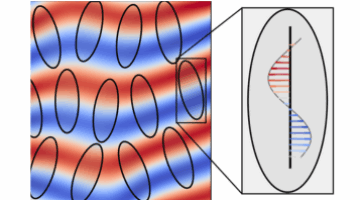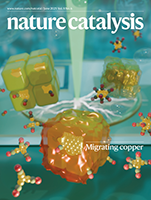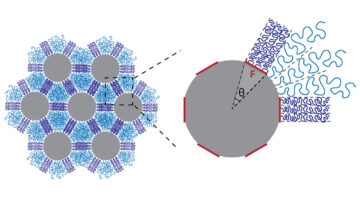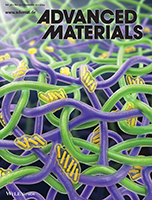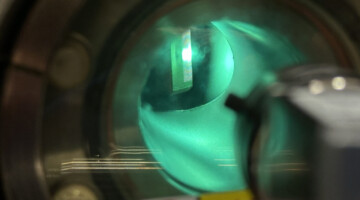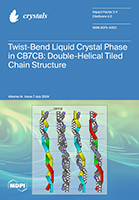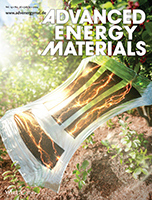During a series of experiments at the ALS, researchers identified helical magnetic spins that fluctuate at different time scales during a phase transition as a function of temperature in a nematic iron germanium thin film. The results provide a framework for characterizing exotic phases, which may have interesting optical and transport properties for microelectronics and spintronics. Read more »![]()
![]()
ALS Work Using RSoXS
Resonant soft x-ray scattering (RSoXS) combines conventional small-angle x-ray scattering (SAXS) with soft x-ray absorption spectroscopy (XAS) for a chemically sensitive structure probe that unambiguously deciphers the complex morphologies of mesoscale materials. The scattering contributions from the different components can be selectively enhanced by tuning the x-ray photon energy to match the absorption spectrum of different chemical components. RSoXS has been applied to structured polymer assemblies, organic electronics, functional nanocomposites, liquid crystals, and bio/biohybrid materials.
Operando probing dynamic migration of copper carbonyl during electrocatalytic CO2 reduction
In their work, Peidong Yang and colleagues reveal the dynamic evolution from faceted Cu nanocatalysts into metallic nanograins during CO2 reduction driven by the surface migration of electrogenerated copper carbonyl. Read more »
Building a Gated-Access Fast Lane for Ions
In organic conductors where charge is carried by both electrons and ions, scientists have discovered a way to make the ions move more than ten times faster than in comparable ion-transport methods. The results could apply to a host of areas, including improved battery charging, biosensing, soft robotics, and neuromorphic computing. Read more »
A New Way to Engineer Composite Materials
A new study led by researchers at Berkeley Lab outlines a way to engineer pseudo-bonds in materials. Instead of forming chemical bonds, which is what makes epoxies and other composites so tough, the chains of molecules entangle in a way that is fully reversible. Read more »
Local Chemical Enhancement and Gating of Organic Coordinated Ionic-Electronic Transport
Record ion mobility and conductivities are revealed within a nanoscopic interfacial superhighway of an organic mixed ionic-electronic conductor. Fast ion transport can be controlled by hydrophobicity of molecules local to this channel, effectively gating ion access to the superhighway. This mechanism is used in a novel chemical sensing device which detects the dynamics of a local, buried chemical reaction. Read more »
Jamming Giant Molecules at Interface in Organic Photovoltaics to Improve Performance and Stability
Giant molecule acceptors (GMAs), known for their large size and intricate functional structures, are an emerging focus in materials science. Through implementation of an interface-enhanced layer-by-layer fabrication strategy, we have successfully demonstrated that GMA with designed electronic structure at interfaces can effectively improve OPV device performance. Read more »
Strategic ALS Projects Reach Key Milestones
Thanks to the hard work and dedication of multidisciplinary teams from groups across the ALS, a spate of important milestones occurred over the past month, for projects involving the new QERLIN beamline, the MERLIN beamline upgrade, and a new chamber for computer-chip metrology in Sector 12. Read more »
Double-Helical Tiled Chain Structure of the Twist-Bend Liquid Crystal Phase in CB7CB
The structure of the twist-bend (TB) phase of the bent dimer CB7CB and its mixtures with 5CB is characterized, revealing a hidden invariance of the self-assembly of the TB structure. Remarkably, the distance along the length for a single turn of this helix is given by 2πRmol, where Rmol is the radius of the bend curvature of a single all-trans CB7CB molecule. Read more »
A Novel Staircase Pattern in Spin-Stripe Periodicity
Striped patterns of spins in a magnetic thin film were found to evolve under an applied magnetic field in steps reminiscent of a structure known as the “Devil’s Staircase.” Such studies are valuable for understanding competing interactions at the atomic level for applications such as magnetic sensors and spintronic devices. Read more »![]()
![]()
Establishing Co-Continuous Network of Conjugated Polymers and Elastomers for High-Performance Polymer Solar Cells with Extreme Stretchability
Researchers developed intrinsically stretchable organic solar cells (IS-OSCs) with exceptional mechanical robustness, by constructing co-continuous networks of conjugated polymers (D18) and elastomers (SEBS) in photoactive layers. The resulting IS-OSCs preserve 86% of their initial efficiency at 50% strain, demonstrating potential for wearable applications. Read more »
- 1
- 2
- 3
- 4
- Next Page »
